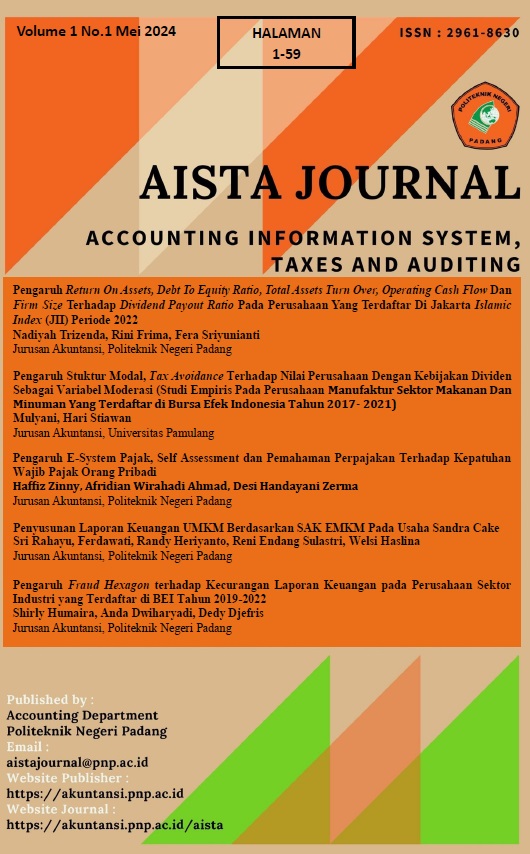Rancangan input-ouput Pengembangan Aplikasi AFAD untuk Pembukuan perusahaan yang memiliki usaha jasa dan dagang
DOI:
https://doi.org/10.30630/aista.v1i1.5Keywords:
Laporan keuangan, Microsoft Access, Program Aplikasi Komputer, Database, SAK EMKMAbstract
This study aims to design an application program for financial reporting at the Mardhotillah Truss Store quickly and automatically using Microsoft Access. The results of the study found deficiencies in the Mardhotillah Truss Store, namely in terms of recording transactions and in preparing financial statements. Therefore, the author provides a solution for Mardhotillah Truss Stores to use the Microsoft Access computer application to assist the Store in recording transactions and preparing financial reports in accordance with the Financial Accounting Standards for Micro, Small and Medium Entities (SAK EMKM) quickly and automatically. This application has advantages because the form uses Visual Basic for Application (VBA) and there is a login facility. The forms used for transaction input are the account list form, the fixed asset list form, the goods list form, the goods category list form, the supplier list form, the customer list form, the service type list form, the wage rate list form, and the initial balance form for accounts receivable, the form beginning balance of debt, beginning of inventory balance form, sales form, purchase form, debt payment form, receivable receipt form, service order form, completed service form, fixed asset depreciation posting form, closing journal posting form and general journal form. This application generates the required reports, namely financial statements (profit and loss statements, changes in equity reports, statements of financial position) and transaction reports.
References
Apip, Mohamad & Syaiful Akbar, D. (2016). Pengantar Akuntansi 1. Ciamis.
IAI. (2016). Standar Akuntansi Keuangan Entitas Mikro, Kecil, dan Menengah.
Jakarta: DSAK IAI
Hutauruk, M. R. (2017). Akuntansi Perusahaan Jasa Aplikasi Program Zahir Accounting Versi 6. Jakarta: PT. Indeks.
Ikhsan, A., & Suprasto, H. B. (2008).Teori Akuntansi & Riset Multiparadigma.Yogyakarta: Graha Ilmu.
Mangkulo, H. A. (2010). Microsoft Accesss 2010 untuk Pemula. Jakarta: PT Elex Media Komputindo.
Muda,K.W. (2014). Modul Pengantar Akuntansi. Jakarta
Muhlis, Ahmad, Anggraini, & Dita (2015). Aplikasi Toko, Akuntansi, dan Penggajian. Jakarta:
PT Elex Media Komputindo.
Pura, R. (2012). Pengantar Akuntansi I Pendekatan Siklus Akuntansi. Jakarta: Erlangga.
Rudianto. (2012). Pengantar Akuntansi Adaptasi IFRS. Jakarta: Erlangga.
Sinarwati, N. K. (2019). Pengantar Akuntansi 2. Bali: Undhiksha.
Sofia Prima Dewi, E. S. (2017). Pengantar Akuntansi Sekilas Pandang Perbandingan dengan SAK yang mengadopsi IFRS, SAK ETAP, dan SAK EMKM. Bogor: In Media.
Sulistiyowati, L. (2010). Panduan Praktis Memahami Laporan Keuangan.
Zamzami, F., & Nusa, N. D. (2016). Akuntansi Pengantar 1. Yogyakarta: Gadjah Mada University Press.
Downloads
Published
How to Cite
Issue
Section
License
Copyright (c) 2022 Endrawati Endrawati

This work is licensed under a Creative Commons Attribution 4.0 International License.








